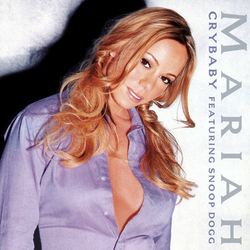| "Crybaby" | ||||
|---|---|---|---|---|
 | ||||
| Single by Mariah Carey featuring Snoop Dogg | ||||
| from the album Rainbow | ||||
| A-side | "Can't Take That Away (Mariah's Theme)" | |||
| Released | April 17, 2000 | |||
| Recorded | June 1999 | |||
| Studio |
| |||
| Genre | R&B | |||
| Length | 5:19 (album version) 4:31 (radio edit) | |||
| Label | Columbia | |||
| Songwriter(s) |
| |||
| Producer(s) |
| |||
| Mariah Carey singles chronology | ||||
| ||||
| Snoop Dogg singles chronology | ||||
| ||||
| Music video | ||||
| "Crybaby" on YouTube | ||||
"Crybaby" is a song by American singer-songwriter Mariah Carey featuring American rapper Snoop Dogg. It was released on April 17,2000 by Columbia Records as a double A-side with "Can't Take That Away (Mariah's Theme)". It was written by Carey and Snoop Dogg,and produced by the former and Damizza for Carey's seventh studio album, Rainbow (1999). It serves as the album's fourth single. It features Snoop Dogg throughout the song's bridge and is built around a sample of the 1988 song "Piece of My Love," originally performed by Guy and written by Teddy Riley,Aaron Hall,Timmy Gatling and Gene Griffin. Throughout the song,the protagonist reveals the struggles of dealing with insomnia and thoughts of a past relationship during the night,as she spirals out of control and declares "I gotta get me some sleep."
Contents
- Background and composition
- Label dispute
- Reception
- Critical reception
- Commercial performance
- Music video
- Live performances
- Track listing and formats
- Credits and personnel
- Charts
- Release history
- References
- Further reading
The song was the center of a very public controversy between Carey and her label Sony Music Entertainment,due to their lack of promotion of it as a commercial single. It,alongside its A-side "Can't Take That Away (Mariah's Theme)" were not eligible to chart on the Billboard Hot 100,due to the charts rules at the time of their release. Eventually,the song was able to attain a peak of twenty eight,Carey's first single to miss the top twenty. The song's music video features Carey spending a restless night in her apartment,throwing wine and cereal while trying to "get some sleep." Snoop Dogg makes an appearance in the video through a television monitor. Carey performed the song live during her Rainbow World Tour,in support of the album and its singles.
